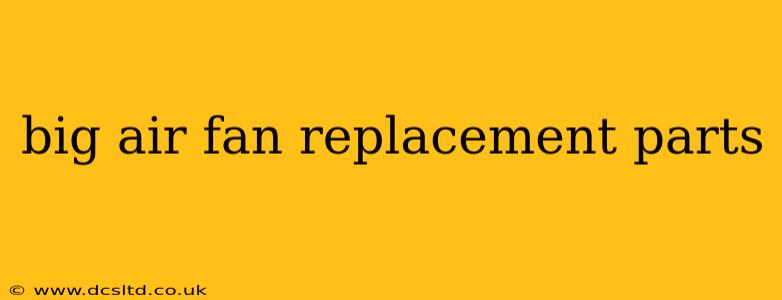Big air fans, whether used for industrial ventilation, agricultural cooling, or even large-scale residential applications, are robust pieces of equipment. However, like any machine, parts eventually wear out or break down. Knowing where to find replacement parts and understanding common issues can save you time, money, and potential downtime. This guide will delve into the common replacement parts needed for big air fans, troubleshooting tips, and resources to help you get back up and running quickly.
What are the Most Common Big Air Fan Replacement Parts?
The specific parts you'll need will depend on the make, model, and size of your big air fan. However, some components are universally common across most large-scale fans:
1. Blades:
These are arguably the most crucial components. Damage can occur from impact, fatigue (due to prolonged use), or even corrosion. Finding replacement blades that exactly match your fan's specifications is crucial for maintaining optimal airflow and efficiency. Incorrect blade sizing or shape can lead to imbalance and increased wear on other components.
2. Motors:
The heart of the fan, the motor provides the power needed for rotation. Motor failure can result from overheating (due to bearing failure or excessive load), electrical issues, or simply the end of its lifespan. Replacing a motor often requires professional assistance due to electrical connections and safety precautions.
3. Bearings:
These are responsible for supporting the rotating shaft and minimizing friction. Worn-out bearings can lead to noisy operation, vibrations, and ultimately, motor failure. Regular lubrication can extend the life of bearings, but eventually, replacement will be necessary. Different fan types utilize different bearing types (ball bearings, roller bearings, etc.), so ensuring compatibility is critical.
4. Belts (for belt-driven fans):
Belt-driven fans utilize belts to transmit power from the motor to the fan blades. Over time, belts can stretch, crack, or break. Replacing a broken belt is usually a straightforward process, though choosing the correct belt size and type is essential.
5. Housing/Casing:
The housing protects the internal components. Damage to the casing can result from impacts, corrosion, or simply age-related degradation. Repairing or replacing damaged housing parts is important for maintaining the fan's structural integrity and safety.
6. Switches and Controls:
Depending on the fan’s complexity, you may need to replace switches, circuit breakers, or control panels. These components are crucial for safe operation and should be replaced promptly if faulty. Always consult the manufacturer's instructions or a qualified electrician when working with electrical components.
Where Can I Find Replacement Parts for My Big Air Fan?
Several avenues exist for sourcing replacement parts for your big air fan:
- Manufacturer Directly: This is often the best source for genuine parts guaranteeing compatibility and warranty coverage.
- Authorized Dealers: These distributors carry genuine parts and often provide technical support.
- Online Retailers: Sites like Amazon, eBay, and specialized industrial supply websites may offer a wide selection of parts, but verify compatibility carefully before purchasing.
- Local Industrial Supply Stores: These stores often stock common replacement parts for various industrial equipment.
How Can I Troubleshoot My Big Air Fan Before Ordering Parts?
Before ordering replacement parts, take some time to troubleshoot the problem. This can save you time and money by preventing unnecessary purchases.
Common Problems & Troubleshooting Steps:
- Fan Won't Start: Check power supply, fuses, circuit breakers, and the motor itself.
- Fan Runs Noisily: Investigate bearings for wear, check for blade imbalance, and ensure proper belt tension (if applicable).
- Fan Doesn't Deliver Sufficient Airflow: Inspect blades for damage, ensure proper motor speed, and check for obstructions in the air intake or outlet.
- Fan Vibrates Excessively: Check for loose components, bearing wear, and blade imbalance.
What are the Signs that My Big Air Fan Needs Replacement Parts?
Several warning signs indicate that your big air fan needs attention:
- Unusual Noises: Rattling, squealing, or grinding sounds often signal bearing wear or other mechanical issues.
- Reduced Airflow: A significant drop in airflow indicates problems with the blades, motor, or other components.
- Excessive Vibration: Strong vibrations can damage other parts and indicate an imbalance or bearing problems.
- Overheating: If the motor or surrounding areas get excessively hot, it could indicate a motor issue or air blockage.
Regular inspections and preventative maintenance will help extend the lifespan of your big air fan and reduce the need for frequent repairs. Remember to always follow safety precautions when working with industrial equipment. If unsure about any repair, seek professional help.
